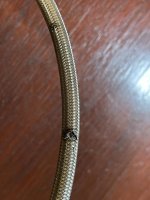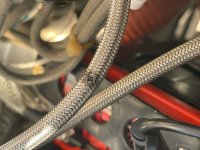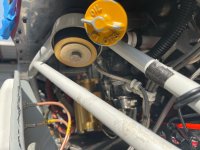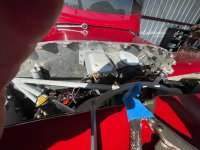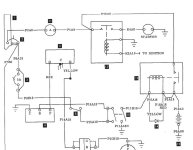I had an interesting thing happen the past 2 days. I did an update on my G3X and I guess I took too long with the update and checking some settings. I tried to start my plane and just clicking and small movement of the prop. I tried charging overnight but still no go in the morning. I bought a new PC680 and when I was installing it I touched the wrench to what I thought was the motor mount. I finished installing the battery and putting the top cowl back on I noticed a black spot on the oil pressure hose. My first thought was what was it rubbing on to make it black?
I put my glasses on and felt it. Then I remembered the ark and wondered if that was it. I took a couple pictures and sent them to Tom at TS Flightlines asking if he thought the line needed to be replaced before further flight. It really didnt look that bad to me. He said - do not fly! I have my check ride to FINALLY get my license scheduled for Friday. Ugg!! Tom told me to order new ones online and to contact Steve at Aircraft Specialties. Steve called me almost instantly and said he would build the hoses and get them sent overnight so I will have them tomorrow. What great service. I appreciate them rushing this for me.
I was advised to have the hoses fire sleeved. That is something I had never considered or even known it was a good idea. It is a good idea - do it now. Besides saving the cost of new hoses it is VERY easy to not notice and it could make your flight end really bad.
The hose was from the pressure manifold on the firewall to the engine near the mag. It is really easy to short out when changing the battery or even hooking up a charger. I cant wait to install my new hoses tomorrow.
I put my glasses on and felt it. Then I remembered the ark and wondered if that was it. I took a couple pictures and sent them to Tom at TS Flightlines asking if he thought the line needed to be replaced before further flight. It really didnt look that bad to me. He said - do not fly! I have my check ride to FINALLY get my license scheduled for Friday. Ugg!! Tom told me to order new ones online and to contact Steve at Aircraft Specialties. Steve called me almost instantly and said he would build the hoses and get them sent overnight so I will have them tomorrow. What great service. I appreciate them rushing this for me.
I was advised to have the hoses fire sleeved. That is something I had never considered or even known it was a good idea. It is a good idea - do it now. Besides saving the cost of new hoses it is VERY easy to not notice and it could make your flight end really bad.
The hose was from the pressure manifold on the firewall to the engine near the mag. It is really easy to short out when changing the battery or even hooking up a charger. I cant wait to install my new hoses tomorrow.



